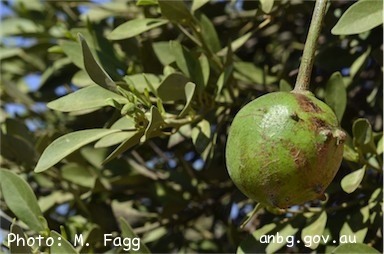Indigenous Australians enjoyed a diverse supply of interesting edible plants in the millennia before white settlement. Some, like macadamias, have been cultivated widely around the world for many years, but in the last few decades other lesser known “bush tucker” plants, of bushfoods, have been discovered by modern Australian chefs and gardeners. One of the estimated 5,000 edible plant species across Australia is Capparis mitchellii, commonly known as Wild Orange, Native Pomegranate or Mitchell’s Bumble Tree. The attraction of growing and eating these plants is not only their high nutritional value and unique flavours, but that they also provide habitat for native birds and insects and, therefore, a way of maintaining biodiversity.
Capparis mitchellii is a thorny tree which grows about six to eight metres high and four to six metres wide. It is slow growing. It apparently has a role in the dreaming stories of the Adnyamanthanha people of Northern Flinders Range, South Australia. It is not related to the orange of the Citrus genus. Instead it is of the same genus as capers (best known for their edible flower buds and fruit, both of which are usually eaten pickled).
Position
It is suitable for growing in temperate, Mediterranean, semi-arid or arid climates. It has a wide distribution in Australia being found in the Northern Territory, New South Wales, Queensland, South Australia and Western Australia. The plant is drought and frost tolerant, but does not like humidity. It grows best in full sun.
Soil
Capparis mitchelli will tolerate a wide range of soil types, including sandy, sandy loam and clay loam and needs good drainage. It prefers a soil pH of neutral to mildly acidic.
Flowering and fruiting
 Attractive white or creamy-yellow flowers (3-4cm long) can be found at any time of the year. They have long protruding stamens and each flower only lasts for a day. They are followed by round, green fruit that hang from the branches on long curved stalks. When the fruit ripens it turns purplish or dull orange. The flesh becomes yellow to orange and soft with a sweet fragrance. The fruit are around 4-7 cm wide and can be eaten raw or used in cooking. Some say it is tasty, others call it astringent. It has also been described as tasting like passion fruit, with a kerosene aftertaste. The seeds are peppery and best discarded. The skin is bitter and inedible.
Attractive white or creamy-yellow flowers (3-4cm long) can be found at any time of the year. They have long protruding stamens and each flower only lasts for a day. They are followed by round, green fruit that hang from the branches on long curved stalks. When the fruit ripens it turns purplish or dull orange. The flesh becomes yellow to orange and soft with a sweet fragrance. The fruit are around 4-7 cm wide and can be eaten raw or used in cooking. Some say it is tasty, others call it astringent. It has also been described as tasting like passion fruit, with a kerosene aftertaste. The seeds are peppery and best discarded. The skin is bitter and inedible.
Pests and diseases
Caterpillars of the Caper White Butterfly (Belenois java) feed on the Wild Orange. They feed for about three weeks until fully grown then pupate. Butterflies emerge around December. Compared to other caterpillars of their size, they are not big eaters. As a host for the butterfly, the plant provides a good service to the environment. Birds can be a pest as they enjoy the fruit. It is one of the preferred foods of the Spotted Bower Bird.
Propagation
Capparis mitchelli can be grown from cuttings or propagated from seed. The seed does not need pre-treatment and it is possible to buy the seed online. Research has been done on propagating the plant by tissue culture. (The AgriForest Bio-Technologies Ltd company describes tissue culture as “a process that exposes plant tissue to a specific regiment of nutrients, hormones and light under sterile, in vitro conditions to produce many new plants, each a clone of the original mother plant, over a very short period of time.)
Uses
Capparis mitchelli has a high level of Vitamin C and is considered as valuable in the confectionery, flavouring and preservative industries. We couldn’t actually find any recipes, but it seems that the flesh can be stewed and can be used in desserts, cordials or savoury dishes like curries.
If you have a recipe, please let us know!
Banner image: John Tann from Sydney, Australia (Wild Orange fruit) [CC BY 2.0 (https://creativecommons.org/licenses/by/2.0)], via Wikimedia Commons
References
https://digital.library.adelaide.edu.au/dspace/bitstream/2440/77343/8/02whole.pdf
www.gardeningwithangus.com.au/?option=com_plant&view=plant&id=1371&from=botanical
https://en.wikipedia.org/wiki/Capparis_mitchellii
Related Articles:
Garden Journaling – Slow down to tune in.
As we move through the year and our gardens evolve, there's something magical about documenting the journey. Garden journaling is an art that enables…
The Importance of building soil health for a biodeverse, productive garden
Creating a thriving garden that not only sustains itself but also contributes to the broader ecosystem requires more than just sunlight and water.…




